1982-1984 Flowers galore
Moderador: Rein
- Rein
- Usuario Colaborador

- Mensajes: 6258
- Registrado: 13 Mar 2009 15:59
- Ubicación: Leiden, Netherlands
- Contactar:
1982-1984 Flowers galore
The beautiful flower sets in the old Peso, the $A and the ₳ are certainly worth a lot of studies and to some extent might be incorporated in the PyR issues as the flowers are part of Argentina's richess.
From a technical point of view not much has been published here. There is supposed to be a good publication in print issued but I do not know it. The stamps have all been printed in photogravure on the reel-fed Goebel 4-colour printing press that was introduced in late 1968. The perforation was applied in-line that is the perforation device was mounted on the press it self and the stamps got perforated with the web of stamp sheets still uncut. Typical for that perforation is the slightly higher [1 tooth!] portrait shape in comparison to most of the PyR II&III.
There are several misunderstandings about the production fo these sets that should be clarified! Mainly they have to do with the types of paper used and the waty we see these papers reflect under UV light.
From a technical point of view not much has been published here. There is supposed to be a good publication in print issued but I do not know it. The stamps have all been printed in photogravure on the reel-fed Goebel 4-colour printing press that was introduced in late 1968. The perforation was applied in-line that is the perforation device was mounted on the press it self and the stamps got perforated with the web of stamp sheets still uncut. Typical for that perforation is the slightly higher [1 tooth!] portrait shape in comparison to most of the PyR II&III.
There are several misunderstandings about the production fo these sets that should be clarified! Mainly they have to do with the types of paper used and the waty we see these papers reflect under UV light.
- Rein
- Usuario Colaborador

- Mensajes: 6258
- Registrado: 13 Mar 2009 15:59
- Ubicación: Leiden, Netherlands
- Contactar:
Re: 1982-1984 Flowers galore
The stamp paper is described in most publications as "tizado" which is not incorrect by itself.
Unlike previous stamps "tizado" means simply "coated" - covered with a thin layer of china clay or other substance to make the surface that might have been otherwise rather rough be smooth! It does NOT mean that the coated surface is shiny or glossy. That was the case in practically all pre-1982 stamps with coating. So the term "tizado" is bound to confuse people. The coating as I said doesn't have to be shiny and might be so! The coating of the Flowers stamps might have several additives: be it optical brightening agents [white under UV] or otherwise coloured luminescents - either fluorescent [not white] or phosphorescent [yellow, green, red, etc.]. We find only OBa's and yellow phosphorescents in the coatings. The OBA is referred to in Argentina philately as "fluorescencia" [F}; the phosphorescence as "Ph". OBA's can also be added to the paper pulp and hence can be seen only from the back of the stamp. If there is no luminscence added it is called neutral denoted often by "N" or "neutro".
Describing the luminecence from both sides of the stamp - in the case of coated ones - we have the following theoretical combinations: F/F, F/N, Ph/F, Ph/N, F+Ph/F, F+Ph/N and N/N.
F+PH means that both OBA's and phosphorescence had been added to the coatings. This used to be commnon practice as the phosphorescence tends to make the surface of the stamp appear rather yellowish.,.,.
In the article by Solari and Espejo the UV-reaction got an enormous emphasis. Only Solari deals with the flowers in his "Parecen Iguales son diferentes".
Unlike previous stamps "tizado" means simply "coated" - covered with a thin layer of china clay or other substance to make the surface that might have been otherwise rather rough be smooth! It does NOT mean that the coated surface is shiny or glossy. That was the case in practically all pre-1982 stamps with coating. So the term "tizado" is bound to confuse people. The coating as I said doesn't have to be shiny and might be so! The coating of the Flowers stamps might have several additives: be it optical brightening agents [white under UV] or otherwise coloured luminescents - either fluorescent [not white] or phosphorescent [yellow, green, red, etc.]. We find only OBa's and yellow phosphorescents in the coatings. The OBA is referred to in Argentina philately as "fluorescencia" [F}; the phosphorescence as "Ph". OBA's can also be added to the paper pulp and hence can be seen only from the back of the stamp. If there is no luminscence added it is called neutral denoted often by "N" or "neutro".
Describing the luminecence from both sides of the stamp - in the case of coated ones - we have the following theoretical combinations: F/F, F/N, Ph/F, Ph/N, F+Ph/F, F+Ph/N and N/N.
F+PH means that both OBA's and phosphorescence had been added to the coatings. This used to be commnon practice as the phosphorescence tends to make the surface of the stamp appear rather yellowish.,.,.
In the article by Solari and Espejo the UV-reaction got an enormous emphasis. Only Solari deals with the flowers in his "Parecen Iguales son diferentes".
- Rein
- Usuario Colaborador

- Mensajes: 6258
- Registrado: 13 Mar 2009 15:59
- Ubicación: Leiden, Netherlands
- Contactar:
Re: 1982-1984 Flowers galore
Argentina coated paper used to have - quite often - an extra layer of varnish [barnizado] that was applied on the paper before printing or afterwards.
The first set of flowers always has the varnish that sometimes is rather cracked. As to the point of applying it I need to do further studying! The catalogues refer to the paper as tizado- which it is - meaning it is shiny thanks to the varnish, not thanks to the coating! - or mate - which is is as there is no varnish!
So in the first set - T means barnizado [varnished] and M means matt [mate], no varnish!
The second set, however, has no varnish except for a few stamps [2.00, 3.00] but I have just started studying them so othe rmay show up! The basic version is coated paper with no varnish so all should be referred to as "M" rather "T". The few stamps have varnish were probably printed on left-overs from the previous set!!
The third set is like the second set, no varnish.
The complication writers like Solari make is to distinguish an intermediate semi-mate!
In the period up until 1971 "mate" equals uncoated, but then also the watermark stops [a few CdM's excluded] and practically all commemoratives got printed in offset-litho [a few combined with recess] on sheet-fed printing presses. All these stamps could have an extra layer of varnish on top of the coating! The defintives however had been printed predominantly on the newly acquired Goebel photogravure press - reel-fed ! - having thus an endless stream of paper. Varnishing had become more problematic - usually after printing if at all.
In the 1971-1974 no "mate" papers! In the 1974-1982 period the term "mate" has a completely different meaning - it was a coated paper [tizado !] of a terrible quality that ruined all the finesse of the photogravure printing that I thought for quite some time it was a special of photogravure that had been applied! The catalogues and the article authors call it "mate" what it is compared with the glossy papers! Still everything was TIZADO!
The definitives of the 1982- period starting with the Flowers [the second last great definitive series in photogravure; the Fungi being the last] had coated papers with a matt surface. But the first flower set also had varnished paper.
You can recognize the varnish by the crackling, uneven surface of the stamp paper, later versions of the paper have an evenly smooth surface with a varying shine - not just in the intensity but also the position of the shiny spots!

Solari describes it as ranging from "brilloso", "poco brilloso" to "sin brillo"; it is a continuum, NOT 3 distinguished types of paper ....
The first set of flowers always has the varnish that sometimes is rather cracked. As to the point of applying it I need to do further studying! The catalogues refer to the paper as tizado- which it is - meaning it is shiny thanks to the varnish, not thanks to the coating! - or mate - which is is as there is no varnish!
So in the first set - T means barnizado [varnished] and M means matt [mate], no varnish!
The second set, however, has no varnish except for a few stamps [2.00, 3.00] but I have just started studying them so othe rmay show up! The basic version is coated paper with no varnish so all should be referred to as "M" rather "T". The few stamps have varnish were probably printed on left-overs from the previous set!!
The third set is like the second set, no varnish.
The complication writers like Solari make is to distinguish an intermediate semi-mate!
In the period up until 1971 "mate" equals uncoated, but then also the watermark stops [a few CdM's excluded] and practically all commemoratives got printed in offset-litho [a few combined with recess] on sheet-fed printing presses. All these stamps could have an extra layer of varnish on top of the coating! The defintives however had been printed predominantly on the newly acquired Goebel photogravure press - reel-fed ! - having thus an endless stream of paper. Varnishing had become more problematic - usually after printing if at all.
In the 1971-1974 no "mate" papers! In the 1974-1982 period the term "mate" has a completely different meaning - it was a coated paper [tizado !] of a terrible quality that ruined all the finesse of the photogravure printing that I thought for quite some time it was a special of photogravure that had been applied! The catalogues and the article authors call it "mate" what it is compared with the glossy papers! Still everything was TIZADO!
The definitives of the 1982- period starting with the Flowers [the second last great definitive series in photogravure; the Fungi being the last] had coated papers with a matt surface. But the first flower set also had varnished paper.
You can recognize the varnish by the crackling, uneven surface of the stamp paper, later versions of the paper have an evenly smooth surface with a varying shine - not just in the intensity but also the position of the shiny spots!

Solari describes it as ranging from "brilloso", "poco brilloso" to "sin brillo"; it is a continuum, NOT 3 distinguished types of paper ....
- Rein
- Usuario Colaborador

- Mensajes: 6258
- Registrado: 13 Mar 2009 15:59
- Ubicación: Leiden, Netherlands
- Contactar:
Re: 1982-1984 Flowers galore
The new aspect both writers like Espejo and Solari stress is the effect of a paper under the Ultraviolet lamp! In the late 1950-ies the general use of Optical Brightening Agents started to make everything WHITER than WHITE! Washing powders were the first target. And with the OBA's in the the textile fibres, the OBA found its way in the papers by means of white fluorescent fibres contrasting with the remainders of the paper pulp. By the early 1960-ies OBA's were deliberately added to the paper pulp as well AND to the substance used for coatings!
Fluorescence as mentioned by Espejo and Solari always refers to these OBA's. When the paper is uncoated both sides of the paper reflect the same way under UV! When the paper is coated, the front of the stamp may not let through the white fluorescence or just a little bit. Has OBA been added to the coating, it may happen that the coating gives a whiter reflection than the back of the stamp. So we should ALWAYS describe both sides of a stamp in terms of the intensity or absence/presence of OBA's!
The big problem lies in desribing the intensity! You can add salt to your soup and you taste it immediately, but when you pour half a kilo of salt in it, you spoil the soup. Somehow, there is an accepted intensity you should not pass.... But when you buy pre-prepared packets of soup yolu got a whole range of saltiness that you cannot easily sort out in 2 or 3 subdivisions. The soup manufacturers will not let you, just be glad that they mention the amount of salt on the sachets....
The same with the paper manufacturers, the variation of OBA's can NOT be classified! It is there or not! Solari tries a "neutro", "intemedio" and "fluorescente", but that is in vain! He also refers to the back of a stamp only, not to the front that might give different results under UV.
The use of OBA has been highly discussed since the 1980-ies; it is supposed to harm the environment so it got restricted a bit (or a lot) An OBA-free paper is the standard now, that is the OBA in the paper pulp, the coatings usually still have the OBA's!
The 3rd Flowers series (with Australes) has almost exclusively the "Semimate" according to Solari:

What intrigues me is the OBA of the coating that is supposed to be stronger than that of the paper pulp!
Anyhow, getting into the UV-reactions and the different surfaces is the WORST start you can wish for a beginner. I may continue to describe a few things you have to take into account and it may go a lot further than Solari. And I can promise you that you will drown! If you want a beginning collector to have fun with the flowers let him/her look for all the spots, dots and threads in all 4 colours before he/she can lay their hands on complete sheets.
rc2158
Fluorescence as mentioned by Espejo and Solari always refers to these OBA's. When the paper is uncoated both sides of the paper reflect the same way under UV! When the paper is coated, the front of the stamp may not let through the white fluorescence or just a little bit. Has OBA been added to the coating, it may happen that the coating gives a whiter reflection than the back of the stamp. So we should ALWAYS describe both sides of a stamp in terms of the intensity or absence/presence of OBA's!
The big problem lies in desribing the intensity! You can add salt to your soup and you taste it immediately, but when you pour half a kilo of salt in it, you spoil the soup. Somehow, there is an accepted intensity you should not pass.... But when you buy pre-prepared packets of soup yolu got a whole range of saltiness that you cannot easily sort out in 2 or 3 subdivisions. The soup manufacturers will not let you, just be glad that they mention the amount of salt on the sachets....
The same with the paper manufacturers, the variation of OBA's can NOT be classified! It is there or not! Solari tries a "neutro", "intemedio" and "fluorescente", but that is in vain! He also refers to the back of a stamp only, not to the front that might give different results under UV.
The use of OBA has been highly discussed since the 1980-ies; it is supposed to harm the environment so it got restricted a bit (or a lot) An OBA-free paper is the standard now, that is the OBA in the paper pulp, the coatings usually still have the OBA's!
The 3rd Flowers series (with Australes) has almost exclusively the "Semimate" according to Solari:

What intrigues me is the OBA of the coating that is supposed to be stronger than that of the paper pulp!
Anyhow, getting into the UV-reactions and the different surfaces is the WORST start you can wish for a beginner. I may continue to describe a few things you have to take into account and it may go a lot further than Solari. And I can promise you that you will drown! If you want a beginning collector to have fun with the flowers let him/her look for all the spots, dots and threads in all 4 colours before he/she can lay their hands on complete sheets.
rc2158
- Rein
- Usuario Colaborador

- Mensajes: 6258
- Registrado: 13 Mar 2009 15:59
- Ubicación: Leiden, Netherlands
- Contactar:
Re: 1982-1984 Flowers galore
What gets understudied are the various printings that can be found without having to see the papers under UV:
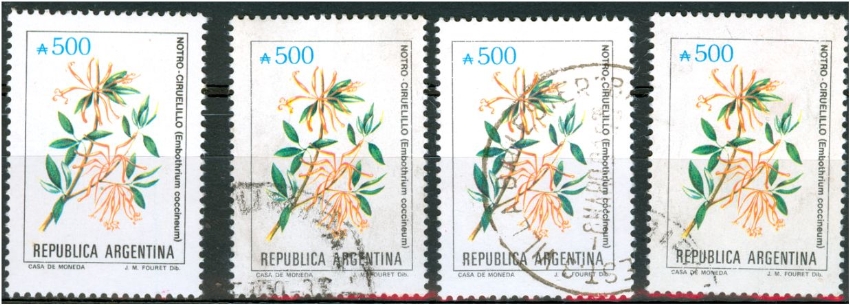

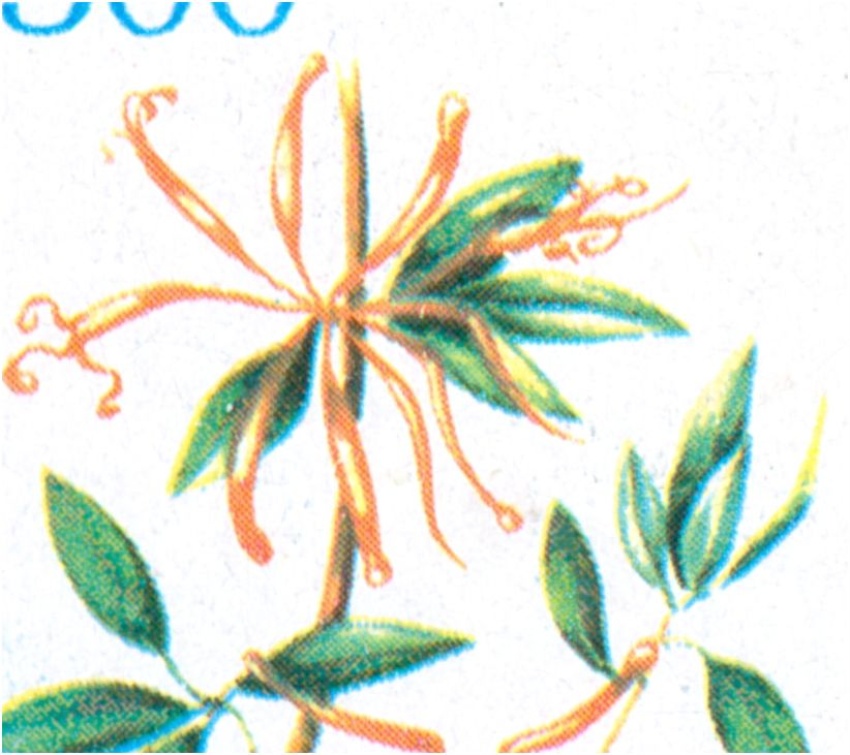
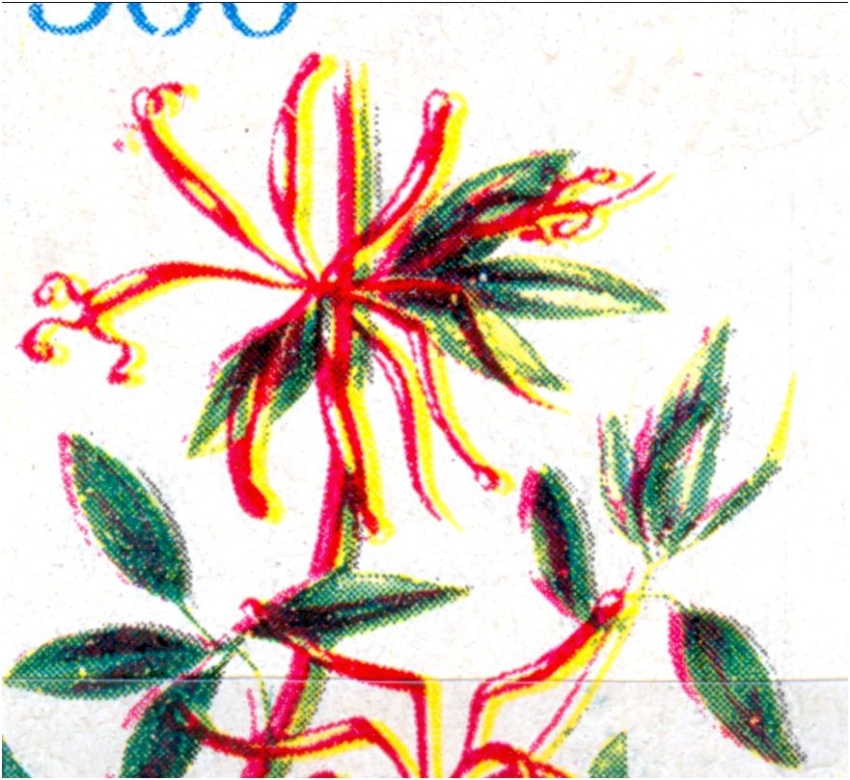
Nothing to be found in Solari:
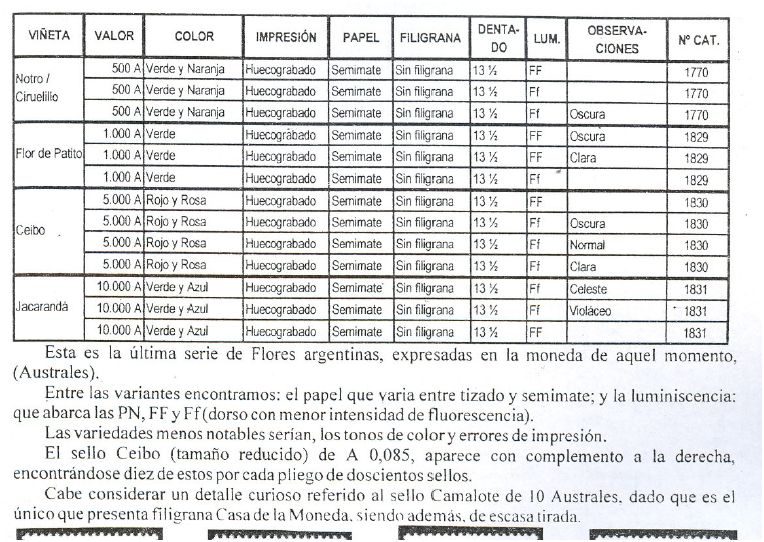
This printing with the heavier colours has a different magenta cylinder - the other colours may have different cylinders as well - AND the magenta and the yellow are terribly misaligned.
The GOEBEL press can have 4 colours and a perforation applied in-line. The 4 colours are called CMYK:
C = cyan or blue
M = magenta or rose red
Y = yellow
K = key or black




Nothing to be found in Solari:

This printing with the heavier colours has a different magenta cylinder - the other colours may have different cylinders as well - AND the magenta and the yellow are terribly misaligned.
The GOEBEL press can have 4 colours and a perforation applied in-line. The 4 colours are called CMYK:
C = cyan or blue
M = magenta or rose red
Y = yellow
K = key or black
- Rein
- Usuario Colaborador

- Mensajes: 6258
- Registrado: 13 Mar 2009 15:59
- Ubicación: Leiden, Netherlands
- Contactar:
Re: 1982-1984 Flowers galore
Another example of discrete printings had been given by Alejandra Marchiano [vicariasca]:
the $A 5.00 "without" red is the more common, I wrote "without" as there is always some magenta [red] to be seen, but indeed in some stamps the magenta is plenty!
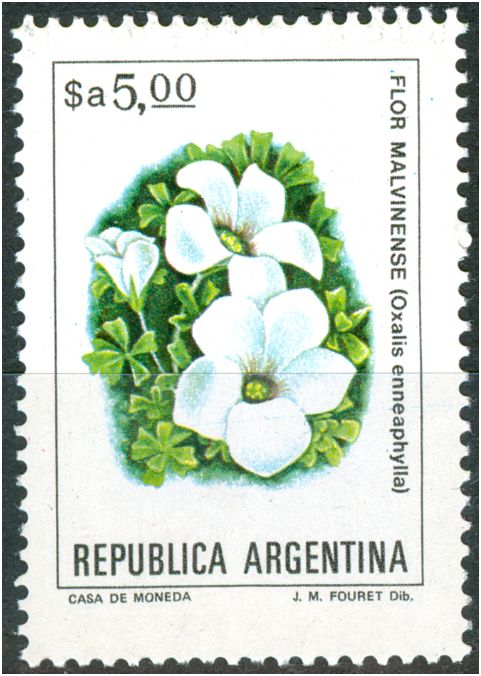
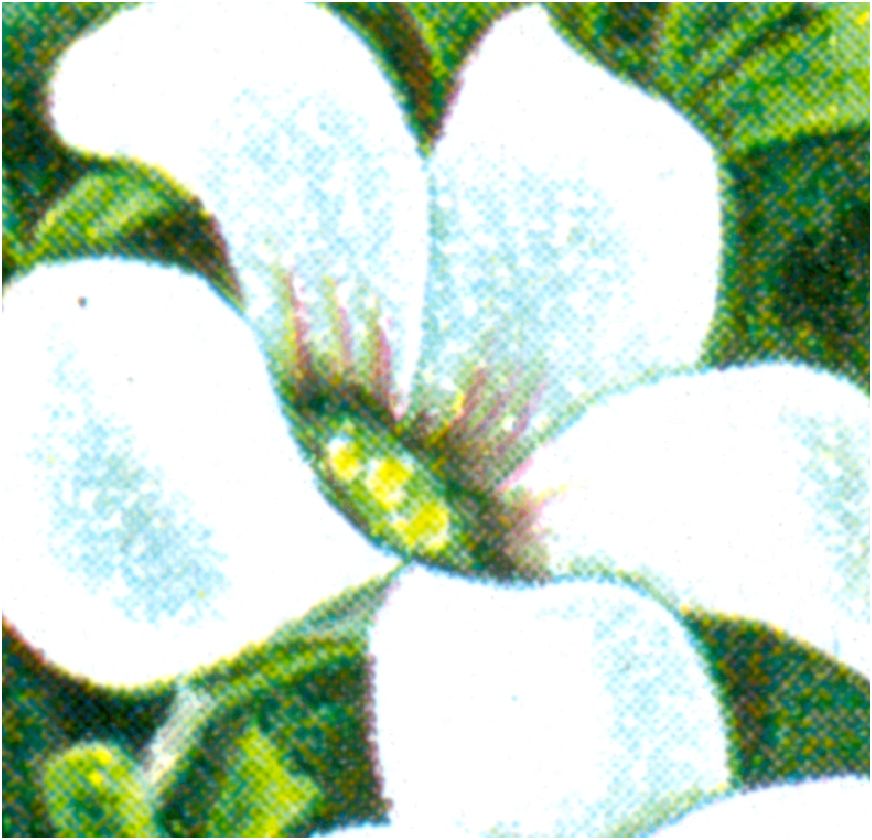
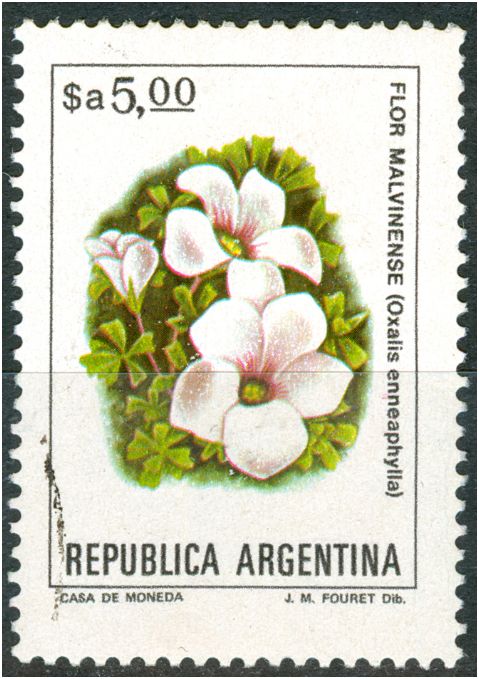
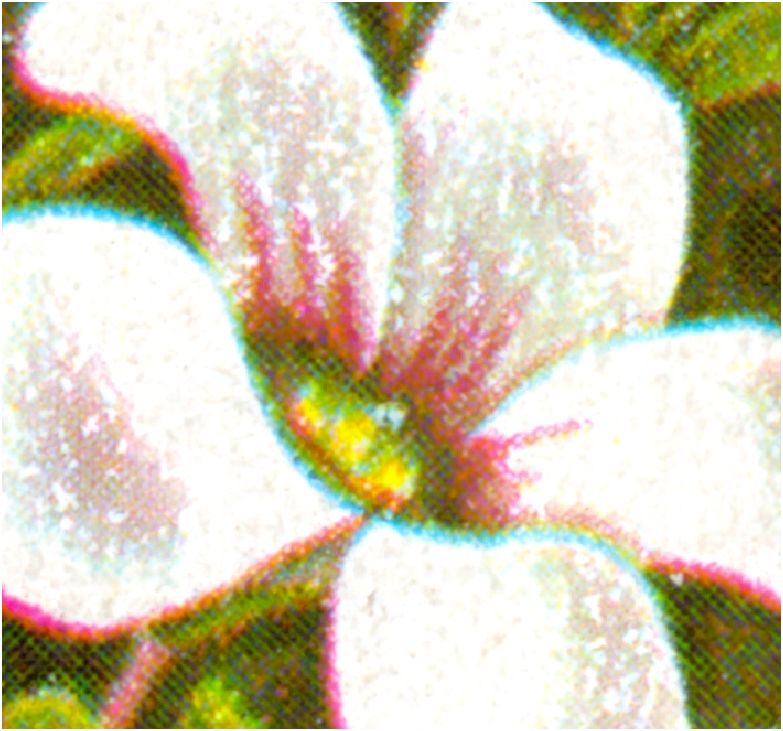
We have 2 different printings here!
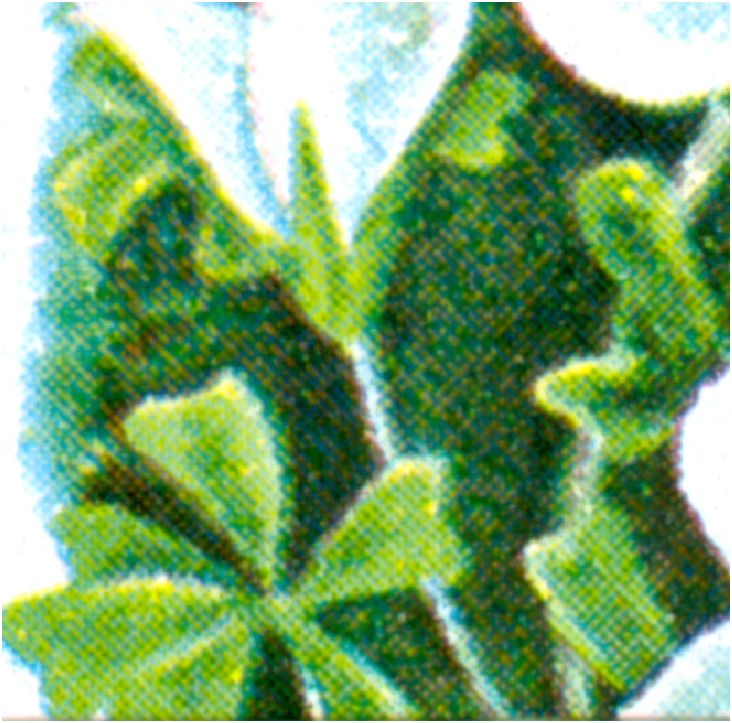
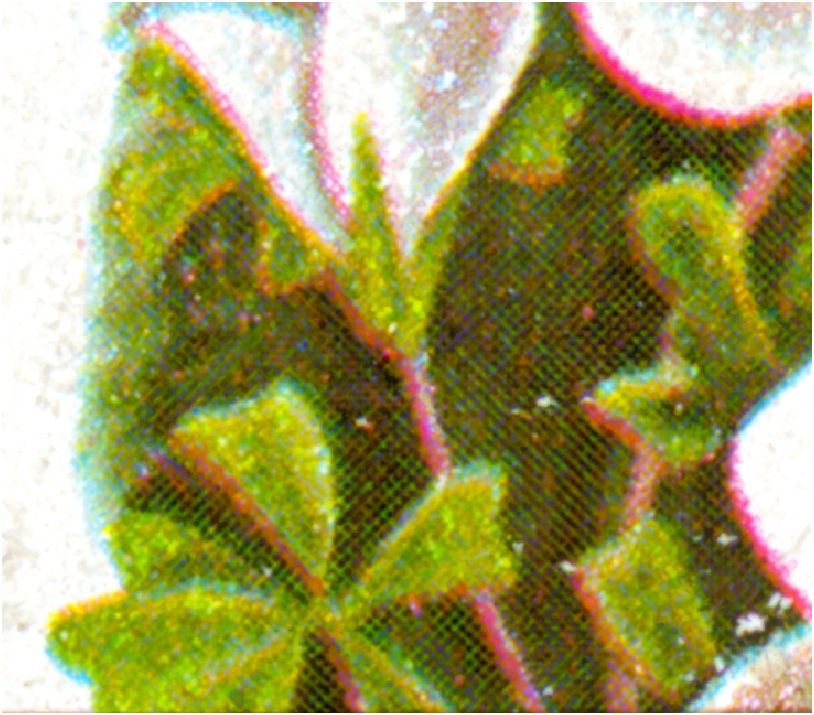
We have in the GJ09 the following:
2109 mate fluorescente 0.40 (mint) 0.10 (used)
2109A tizado fluorescente 1.00 (mint) 0.20 (used)
2109B tizado fluorescente sin color rojo 0.30 ((mint) 0.20 (used)
2109C tizado fosforescente verde y rojo 0.40 (mint) 0.10 (used)
This is a nice mixture of disinformation!
The "sin rojo" variety is NO VARIETY - it is probably a 2nd [or 3rd or 4th] printing with millions of copies AND it has been enlisted by GJ09 although they do not know really how to enlist it.
rc2160
the $A 5.00 "without" red is the more common, I wrote "without" as there is always some magenta [red] to be seen, but indeed in some stamps the magenta is plenty!




We have 2 different printings here!


We have in the GJ09 the following:
2109 mate fluorescente 0.40 (mint) 0.10 (used)
2109A tizado fluorescente 1.00 (mint) 0.20 (used)
2109B tizado fluorescente sin color rojo 0.30 ((mint) 0.20 (used)
2109C tizado fosforescente verde y rojo 0.40 (mint) 0.10 (used)
This is a nice mixture of disinformation!
The "sin rojo" variety is NO VARIETY - it is probably a 2nd [or 3rd or 4th] printing with millions of copies AND it has been enlisted by GJ09 although they do not know really how to enlist it.
rc2160
- Rein
- Usuario Colaborador

- Mensajes: 6258
- Registrado: 13 Mar 2009 15:59
- Ubicación: Leiden, Netherlands
- Contactar:
Re: 1982-1984 Flowers galore
The sets appear to have loads of plate flaws. Maybe they have but the major source of what looks like a plate flaw is a lousy glass screen plate that has dust accumulated for ages... This screen plate - it might have been of plastic as well - will make sure that every dot or scratch is visible in all 4 colours!
So when we have multi-coloured "flaws" they are not flaws of a particular plate or cylinder!
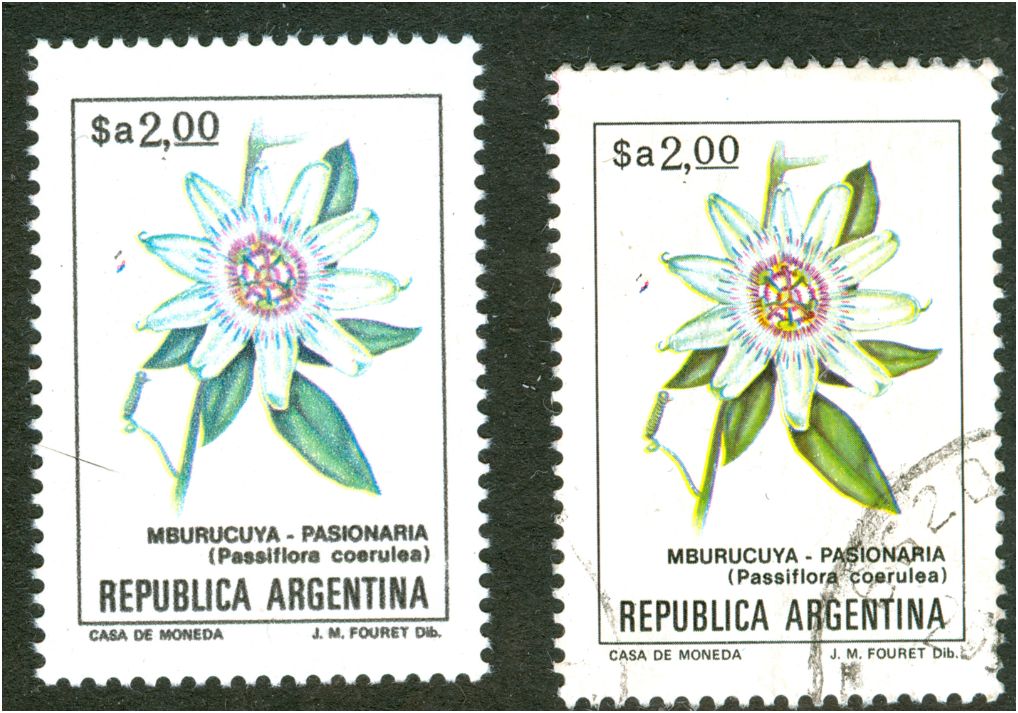
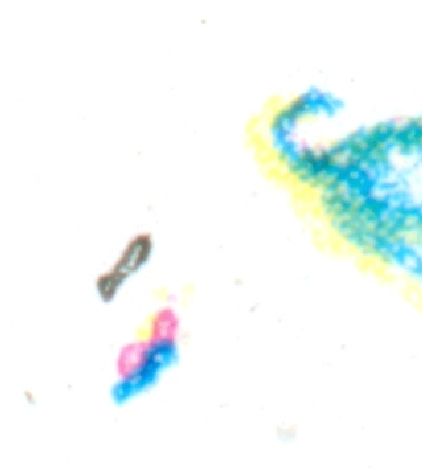
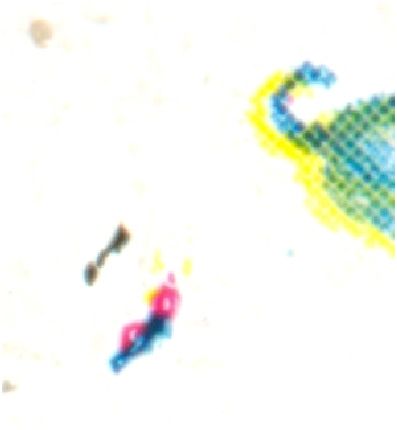
So when we have multi-coloured "flaws" they are not flaws of a particular plate or cylinder!



- Rein
- Usuario Colaborador

- Mensajes: 6258
- Registrado: 13 Mar 2009 15:59
- Ubicación: Leiden, Netherlands
- Contactar:
Re: 1982-1984 Flowers galore
Other characteristics that are colour related and probably occur only once on a printing sheet of 10x10?!
400p:
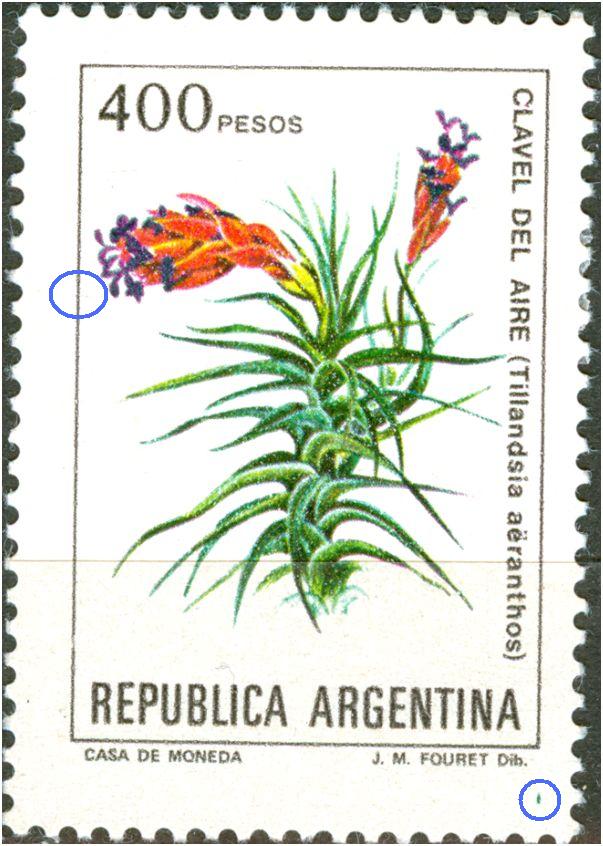
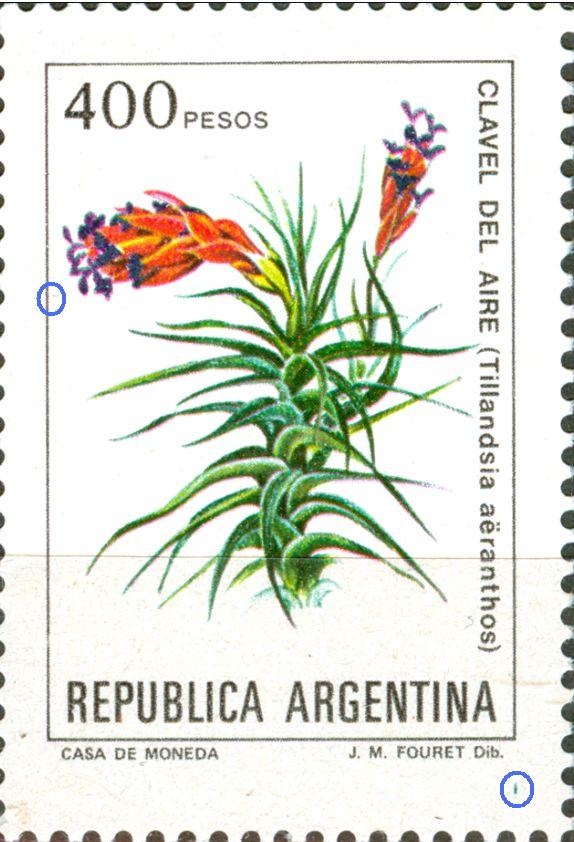
400p:
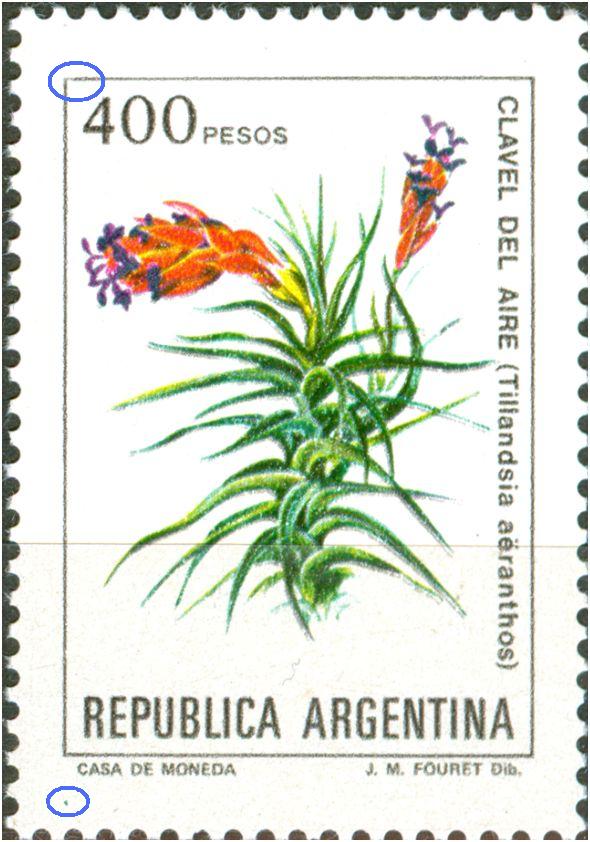
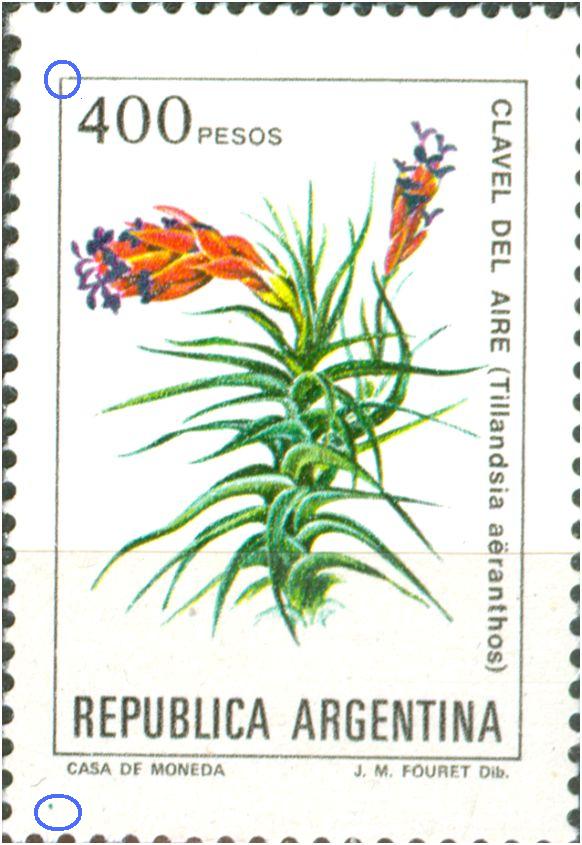
200p:
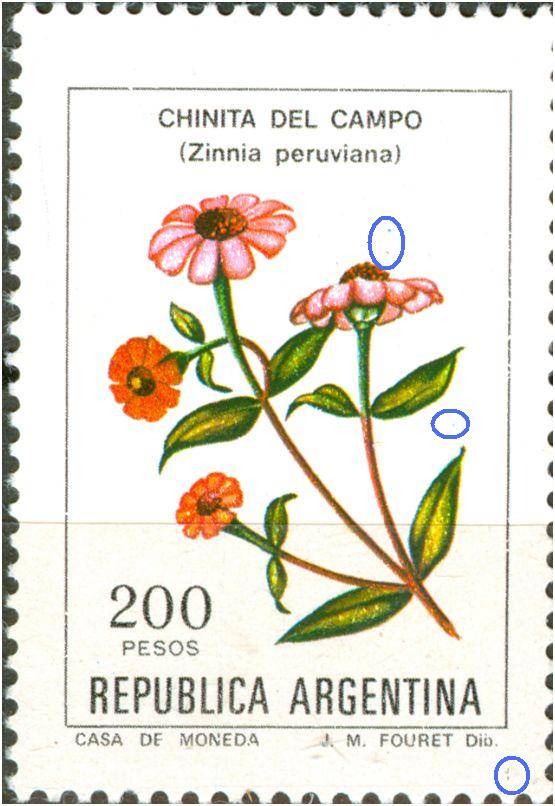
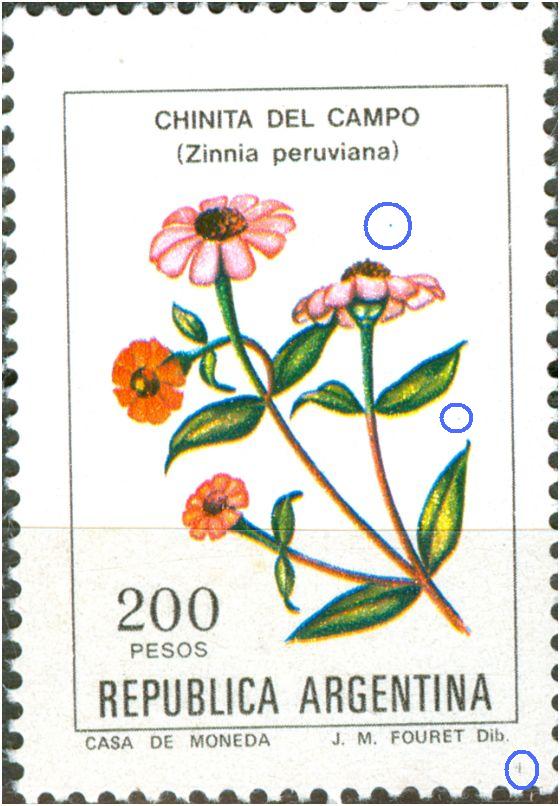
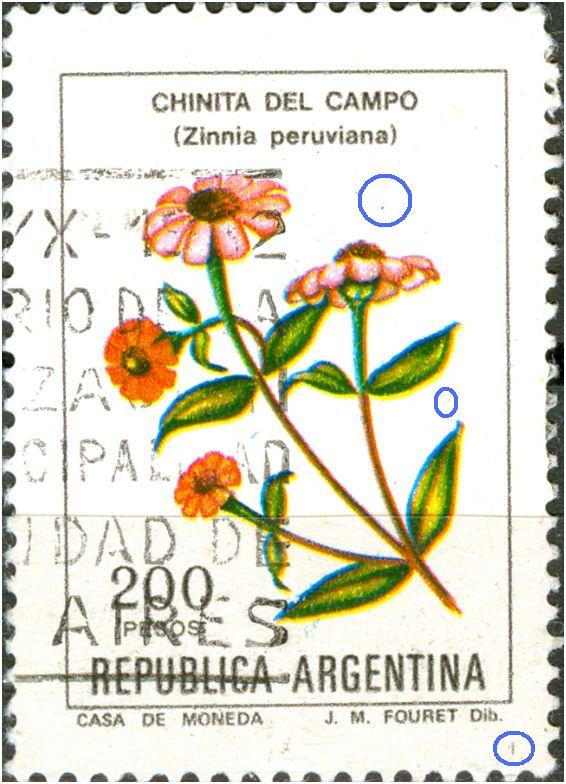
400p:


400p:


200p:



Re: 1982-1984 Flowers galore
A most beautiful series. Have you seen the covers I have?
http://somestamps.com/pages-articles/35 ... covers.htm
tony
http://somestamps.com/pages-articles/35 ... covers.htm
tony
sitio Ingles/Español de P y R I
http://www.somestamps.com/arg3551/index.htm
sitio general:
http://www.somestamps.com/
blog de P y R I en Ingles
http://arg3551.blogspot.com/
http://www.somestamps.com/arg3551/index.htm
sitio general:
http://www.somestamps.com/
blog de P y R I en Ingles
http://arg3551.blogspot.com/
- Rein
- Usuario Colaborador

- Mensajes: 6258
- Registrado: 13 Mar 2009 15:59
- Ubicación: Leiden, Netherlands
- Contactar:
Re: 1982-1984 Flowers galore
Tony,rubiera escribió:A most beautiful series. Have you seen the covers I have?
http://somestamps.com/pages-articles/35 ... covers.htm
tony
yes, I had already had a look at them!
Recently I got parcels with plenty of the same definitives ($10 in twentyfold) instead of the self-adhesive laser-printed stickers... A bit too big to scan really....
- Rein
- Usuario Colaborador

- Mensajes: 6258
- Registrado: 13 Mar 2009 15:59
- Ubicación: Leiden, Netherlands
- Contactar:
Re: 1982-1984 Flowers galore
We have in the GJ09 the following:
2109 mate fluorescente 0.40 (mint) 0.10 (used)
2109A tizado fluorescente 1.00 (mint) 0.20 (used)
2109B tizado fluorescente sin color rojo 0.30 ((mint) 0.20 (used)
2109C tizado fosforescente verde y rojo 0.40 (mint) 0.10 (used)
This is a nice mixture of disinformation!
All flowers series / sets had been printed on coated paper on a 4-colour photogravure reel-fed printing press called the GOEBELin the first place. So they are ALL tizado - what you may notice is a more or less shiny surface due to the application of varnish!
What is essential is the use of a yellow phosphorescent substance in the coating for postal automation purposes; this substance was added to the coating that probably already had a white fluorescent substance added to it [optical brightening agents]. So we have Phosphor (+ OBA = Optical Brightening Agents) in the coating [Guillermo's 2109C] or NO Phosphor just the OBA in the coating [Guillermo's 2109, 2109A and 2109B). The colours have nothing to do with it!!!!
2109 mate fluorescente 0.40 (mint) 0.10 (used)
2109A tizado fluorescente 1.00 (mint) 0.20 (used)
2109B tizado fluorescente sin color rojo 0.30 ((mint) 0.20 (used)
2109C tizado fosforescente verde y rojo 0.40 (mint) 0.10 (used)
This is a nice mixture of disinformation!
All flowers series / sets had been printed on coated paper on a 4-colour photogravure reel-fed printing press called the GOEBELin the first place. So they are ALL tizado - what you may notice is a more or less shiny surface due to the application of varnish!
What is essential is the use of a yellow phosphorescent substance in the coating for postal automation purposes; this substance was added to the coating that probably already had a white fluorescent substance added to it [optical brightening agents]. So we have Phosphor (+ OBA = Optical Brightening Agents) in the coating [Guillermo's 2109C] or NO Phosphor just the OBA in the coating [Guillermo's 2109, 2109A and 2109B). The colours have nothing to do with it!!!!
- Rein
- Usuario Colaborador

- Mensajes: 6258
- Registrado: 13 Mar 2009 15:59
- Ubicación: Leiden, Netherlands
- Contactar:
Re: 1982-1984 Flowers galore
Alejandra,vicariasca » 20 Dec 2009 09:49 escribió: Exacto Rein, para mí son todos tizados. Pero al parecer en el catálogo (GJ) ha hecho una nueva gama de "mates, semimates y tizados" especial para la serie de flores, porque si comparamos con el "papel mate" que se utilizó -por ejemplo- en las series de "próceres y riquezas". Este papel mate NO TIENE NADA QUE VER.
Es el recubrimiento que se le ha colocado al papel que en unas ocasiones aparece más brillante y otras aparece más opaco, denominándola "mate" cuando debería llamarse "cubierta opaca F o Ph" o "cubierta brillante F o PH" para evitar confusiones.
El problema se presenta en los sellos "usados" porque no se puede determinar si tienen cubierta opaca o brillante.
Al parecer es una serie para coleccionar en MINT. , porque con el uso los sellos pierden todos sus atributos originales.
Otro tema es el NEUTRO.... El 90% de los sellos usados -en esta seire- pasan a ser "mate neutro" porque han perdido tanto el F o el PH como el brillo.
Y en los MINT, a veces tienen una capa más oscura que colocados a igual distancia (vgr. del plano de apoyo a la luz UV tienen mucha menos luminosidad que otros ejemplares), pero a los que considero no se les puede denominar NEUTRO, pues al acercarlos a la luz muestran su destello original de F o de PH. Por ende entiendo que el único NEUTRO que puede existir en esta serie, debe ser aquel al que se han olvidado de ponerle el PH o F en uno o en ambos lados. A veces parece ser que la cubierta F o Ph ha sido realizada en ambos lados y otras en uno solo, dando lugar a los FN o NF o NPH o PhN, pero todo esto hay que examinarlo en sellos MINT y generalmente todos tenemos cantidades de estos sellos, pero en USADOS, que no sirven para realizar ningún análisis.
Y en cuanto a los colores, entiendo que no tienen nada que ver con los tipos de papeles, no soy tan tonta. En el caso que vimos le falta un color y en el caso del Jacarandá, éste aparece en color celeste y en color violaceo en todas las oportunidades. Es para seguir estudiando.
Saludos y gracias.
alejandra
"La muerte está tan segura de su triunfo que nos da toda una vida de ventaja"
quite right! Collecting te series in MINT condition seems the best to do, but as it is a normal definitive series we should take care of the used ones just as well. In the used condition it is almost impossible to judge the amount of varnish applied and also the intensity of the optical brightening agents can NOT be established since the OBA in the enveloppes may have transmigrated to the stamps!
So forget about "neutro" and "mate", "semimate" when used stamps are involved! What we can see is whether they have phosphorescence or not!
And what we can do is have a close look at the 4 different colours to see whether new cylinders have been prepared that give a new appearance to certain stamps. Your discovery of the "sin rojo" is worth examining! GJ09 may have it enlisted already but he does not seen to understand what was going on..... I hope you and I can sort this out!!
- Rein
- Usuario Colaborador

- Mensajes: 6258
- Registrado: 13 Mar 2009 15:59
- Ubicación: Leiden, Netherlands
- Contactar:
Re: 1982-1984 Flowers galore
"mate" or matt, not glossy or shiny, has got nothing to with a coating or any addition to the paper surface. It is just a way of saying that there is no reflection of light from the surface of our stamps.
"satinado" or calandering will give the surface some sort of brilliance, shine, gloss - not by adding something to it, but simply during the process of paper making brushing up the paper surface. Like when you polish your shoes without using a polish but just the brush! It will make your shoes look better!
"tizado" or coated means that during the paper making process a thin layer has been applied to the surface of the paper! It can have a matt appearance or a glossy one - usually it is a glossy one, but most of the after 1970 "mate" papers have a coating hence they are "tizado"! But they are not glossy - or most of them. And if they are somehow glossy a bit, we invent the term "semi mate" (page 241 300pesos Flores).
What causes the mess is that nobody realises that there is another way of adding something to make things look better or to protect it. And that is varnish [barnizado]. It will be applied on ready made paper before printing OR after printing to fix the ink. In the latter case you may see the shining of the varnish all over the surface - not just the unprinted parts but also the printed parts!
The use of "barnizado" by the Casa de Moneda is responsible for most of the confusion!!
rc2477
"satinado" or calandering will give the surface some sort of brilliance, shine, gloss - not by adding something to it, but simply during the process of paper making brushing up the paper surface. Like when you polish your shoes without using a polish but just the brush! It will make your shoes look better!
"tizado" or coated means that during the paper making process a thin layer has been applied to the surface of the paper! It can have a matt appearance or a glossy one - usually it is a glossy one, but most of the after 1970 "mate" papers have a coating hence they are "tizado"! But they are not glossy - or most of them. And if they are somehow glossy a bit, we invent the term "semi mate" (page 241 300pesos Flores).
What causes the mess is that nobody realises that there is another way of adding something to make things look better or to protect it. And that is varnish [barnizado]. It will be applied on ready made paper before printing OR after printing to fix the ink. In the latter case you may see the shining of the varnish all over the surface - not just the unprinted parts but also the printed parts!
The use of "barnizado" by the Casa de Moneda is responsible for most of the confusion!!
rc2477
- Rein
- Usuario Colaborador

- Mensajes: 6258
- Registrado: 13 Mar 2009 15:59
- Ubicación: Leiden, Netherlands
- Contactar:
Re: 1982-1984 Flowers galore
Martin,ntrm escribió:
$ 500
Aca se empieza a complicar, separo primero los Fosforescentes de los Fluorescentes... bien, facil.
Ahora agarro los Fosforescentes - Neutro (PN) y tengo 3 papeles... ahi me trabo, porque para ver la diferencia entre el Tizado y el Semimate tomé los valores $ 300 y $ 400, y no encuentro la manera de diferenciar el papel.
Voy a parar aca, para charlar sobre esto.... avancé un poco mas, pero quiero saber que harian y que opinan...
Martin
PD: REIN PIEDAD!!! DESPACIO!!!!!
be prepared for the worse! ALL stamps of the Flower series are coated (or Tizado!) but on top of the coating there is a varnishing (barnizado!) that may give the glossy impression from matt to shining depending on the amount of varnish, the way the varnish had been applied. The effect of the varnish is something that Solari and others have not counted with, the varnishing is a thing that had started in the 1940-ies and had been applied by the Casa de Moneda all the time. Mint stamps may sometimes show off this varnish while the used, washed off stamps may no longer show signs of varnish. The varnish may get applied before printing or afterwards!
- Rein
- Usuario Colaborador

- Mensajes: 6258
- Registrado: 13 Mar 2009 15:59
- Ubicación: Leiden, Netherlands
- Contactar:
Re: 1982-1984 Flowers galore
In the period up until 1971 "mate" equals uncoated, but then also the watermark stops [a few CdM's excluded] and practically all commemoratives got printed in offset-litho [a few combined with recess] on sheet-fed printing presses. All these stamps could have an extra layer of varnish on top of the coating! The defintives however had been printed predominantly on the newly acquired Goebel photogravure press - reel-fed ! - having thus an endless stream of paper. Varnishing had become more problematic - usually after printing if at all.
In the 1971-1974 no "mate" papers! In the 1974-1982 period the term "mate" has a completely different meaning - it was a coated paper [tizado !] of a terrible quality that ruined all the finesse of the photogravure printing that I thought for quite some time it was a special of photogravure that had been applied! The catalogues and the article authors call it "mate" what it is compared with the glossy papers! Still everything was TIZADO!
The definitives of the 1982- period starting with the Flowers [the second last great definitive series in photogravure; the Fungi being the last] had coated papers with a matt surface. But the first flower set also had varnished paper.
You can recognize the varnish by the crackling, uneven surface of the stamp paper, later versions of the paper have an evenly smooth surface with a varying shine - not just in the intensity but also the position of the shiny spots!

Solari describes it as ranging from "brilloso", "poco brilloso" to "sin brillo"; it is a continuum, NOT 3 distinguished types of paper ....
to be continued ....
In the 1971-1974 no "mate" papers! In the 1974-1982 period the term "mate" has a completely different meaning - it was a coated paper [tizado !] of a terrible quality that ruined all the finesse of the photogravure printing that I thought for quite some time it was a special of photogravure that had been applied! The catalogues and the article authors call it "mate" what it is compared with the glossy papers! Still everything was TIZADO!
The definitives of the 1982- period starting with the Flowers [the second last great definitive series in photogravure; the Fungi being the last] had coated papers with a matt surface. But the first flower set also had varnished paper.
You can recognize the varnish by the crackling, uneven surface of the stamp paper, later versions of the paper have an evenly smooth surface with a varying shine - not just in the intensity but also the position of the shiny spots!

Solari describes it as ranging from "brilloso", "poco brilloso" to "sin brillo"; it is a continuum, NOT 3 distinguished types of paper ....
to be continued ....
